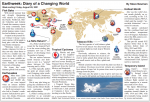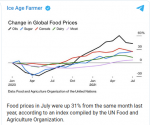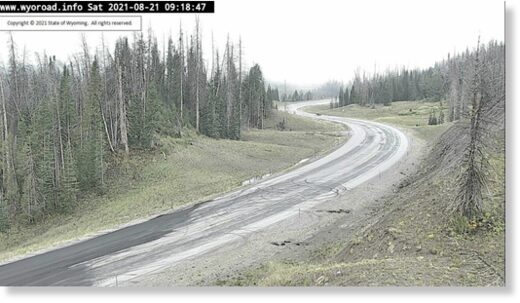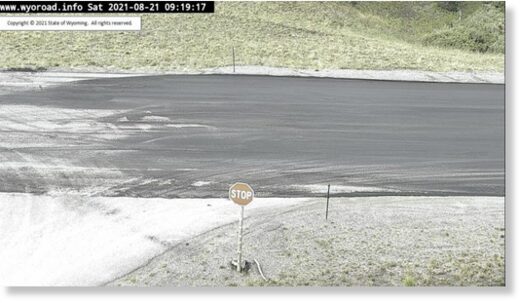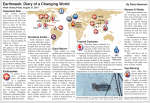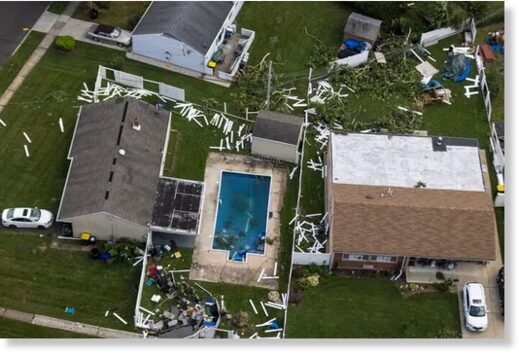"Unseasonal" Snow Blasts Kashmir, South Africa's Food Prices Soar due to Extreme Freeze, European Crop Woes, + Rare Low-Level Snow Hits Tasmania - Electroverse
Crop Loss Extreme Weather GSM
“UNSEASONAL” SNOW BLASTS KASHMIR, SOUTH AFRICA’S FOOD PRICES SOAR DUE TO EXTREME FREEZE, EUROPEAN CROP WOES, + RARE LOW-LEVEL SNOW HITS TASMANIA
AUGUST 17, 2021 CAP ALLON
The MSM appear to be stepping up the EOTW rhetoric of late–if that’s even possible.
A seemingly never-ending barrage of ‘catastrophic global heating’ articles are peppering the western world’s news feeds, and the brainwashed masses continue to fall for every single word of it.
I used to think a journalist’s job was to report the truth, and to provide balance and impartiality — I was naive.
The Smith-Mundt Modernization Act put pay to that.
“UNSEASONAL” SNOW HITS KASHMIR
The higher elevations of India’s Kashmir region reported heavy snowfall and a considerable dip in temperatures on Sunday, according to local meteorologists, and as reported by kashmirreader.com.
The rare summer snowfall was registered at
Amarnath cave, as well as the higher reaches of
Sonamarg.
“There are also reports of snowfall in the mountainous ranges of Drass in the Union Territory of Ladakh,” said one local meteorologist. Heavy snow has also been noted at
Gulmarg, which is located in North Kashmir’s Baramulla district.
View: https://twitter.com/Muneeb93787779/status/1427202859884433411
Run time is 0:30
India has been no stranger to anomalous cold in recent times.
The nation has been breaking low temperature records left, right and center in 2021; in fact, since August 2020,
Delhi has busted at least one major weather record each and every month.
Predictably, the indoctrinated among us are keen to blame this feat on ‘global heating’ and ‘rising atmospheric CO2 levels’–even though the majority of the fallen benchmarks have been cold-related.
In
October last year, Delhi broke a 58-year-old record, clocking a mean minimum temperature of 17.2C (63F):
The unusual chill has persisted into November, too. Delhi logged a "new record low" of 10.8C on Mon, Nov 2.

electroverse.net
In
November, the month’s mean minimum temperature dropped to 10.2C (50F)–a level not seen in 1949.
December witnessed 8 ‘cold wave days’–the highest since 1965. The final month of 2020 also went down as the second-coldest since 1901, and contained its coldest December day since records began more than a century ago.
New cold records have been set in
2021, too.
In
January, record snowfall cut-off Kashmir from the rest of the country.
Delhi then went on to suffer its coldest
May day in 70 years when a high of
just 23.8C (74.8F) was registered on May 19–a reading that went down as the city’s coldest May day since 1951, and one some 16C below the seasonal average:
This COOLING trend is expected to accelerate over the coming months and years as the Sun continues its relative shutdown. Prepare. GSM.

electroverse.net
And in June, India’s capital
Delhi suffered its coldest June temperature ever recorded:
India has been breaking low temperature records all year; in fact, since Aug, 2020 Delhi has busted major weather records each & every month.

electroverse.net
These are hardly signs of ‘catastrophic global heating’. But they went unreported by the MSM –as cold-related realities often do– meaning the masses were never privy to ‘the other side’ of the climate story.
SOUTH AFRICA’S FOOD PRICES SOAR DUE TO EXTREME FREEZE
Snow is continuing to fall over the higher elevations of South Africa, including Lesotho where guests at the Afriski Mountain Resort were treated to “incredible snow conditions this weekend,” according to thesouthafrican.com.
Heavy snow forced the closure of roads and passes in
KwaZulu-Natal and
Eastern Cape on Saturday.
While
Afriski Mountain Resort in Lesotho received
5cm (2 inches) of
global warming goodness on Saturday, and then a further
20cm (8 inches) on Sunday — totals that closed the roads there, too.
View: https://twitter.com/SkiAfriski/status/1426796948888203264
Run time is 0:15
Snow seekers have been treated to dream conditions this year, with this the third reported snowfall in the space of two months, continues
thesouthafrican.com article.
View: https://twitter.com/SkiAfriski/status/1426794675441217538
Similar to India, South Africa has been no stranger to extreme harvest-wrecking chills of late.
Heavy snow has been a common theme across the mountains.
While just last month, an severe Antarctic blast toppled
at least 19 all-time low temperature records:
"I have never had to drive through a snowstorm in Africa before." Welcome to the next Grand Solar Minimum. Prepare.

electroverse.net
As a result of these prolonged low temperatures, South Africa’s food prices have been on the rise.
According to
businessinsider.co.za, the extreme freezes suffered by regions across SA, inducing
Limpopo, have resulted in severe damage to crops including spinach, tomatoes, and peppers. The upshot of this has been a sharp decline of deliveries to fresh produce markets which, in turn, has resulted in prices soaring by at east 20%.
Spinach was the worst affected vegetable, with the price rocketing 27% to R5.13 per kilogram in a just one week. Tomatoes are up 23% to R8.09 per kilogram. While Peppers now cost R11.97, a spike of 20%.
Pieter van Zyl, market analyst for AMT, said the full impact of the recent frost damage is yet to be felt.
“Last week was the third week in a row where tomato prices have risen,” said Zyl.
“Pepper sales have been moving sideways over the past three weeks; however, last week the price rose quite sharply. Many [were] damaged due to the frost … and late last week, producers sent fewer products to the markets,” added Zyl.
Strike Sebake, an agent for Tshwane Market, said even the tomatoes that are making it to the shelves are often not of good quality.While, according to Sebake, other vegetables
spiking are baby marrows, green beans, chilies, and okra.
EUROPEAN CROP WOES
Adverse weather in the European Union has sharply reduced prospects for wheat and barley harvests, contributing to a potentially ‘explosive’ global supply outlook for the cereals, analyst firm Strategie Grains said.
In a monthly report, Strategie Grains reduced its forecast for 2021 soft wheat production in the 27-country EU by 1.5 million tonnes. This reduction has been blamed on the historic flooding in the run-up to harvesting, which has led to disappointing yields in France and Germany. High temperatures in June lowered yields in Poland and northern Europe. While cold conditions across Western Europe in July have hampered growing efforts there.
The recent downgrade, which is by no means disastrous on its own, comes as harvest prospects have also deteriorated in other major exporting regions, such as North America, South America, South Africa, and the Black Sea region (among others).
As a result, Strategie Grains reduced its estimates of world wheat production, including durum, by 14 million tonnes to 750.3 million tonnes, with further reductions all-but guaranteed.
Global wheat demand is expected to expand in 2021/22, and this, combined with the failing harvests, could lead to the
stocks-to-use ratio in major exporting countries falling to its second-lowest level on record, after 2012/13, Strategie Grains said.
Moreover, the quality is also expected to be lower, reflecting the impact of the inclement weather — as a result, the share of livestock feed-grade crop in the soft wheat harvest was expected to be substantially higher.
Projected EU
barley production was lowered
again, by 2 million tonnes from July to 53.0 million tonnes, contributing to a 7 million tonne cut to Strategie Grains’ forecast of global barley output.
These global shortages –which include freezes in South America and droughts in Canada– are threatening “explosive situations for barley and wheat” markets, said Strategie Grains.
It isn’t only grains being negatively impacted, the quality of harvests in
Belgium this year, from grains to fruit and vegetables, has been affected by a cold spring with little sun and then constant heavy rain throughout the summer.
The effects are being felt across the board, with most crops –from pears, the fruit most grown in Belgium, to cereals and the country’s other signature crop, potatoes– reeling from the adverse weather conditions, reports
freshplaza.com.
This year’s yield of pears, for example, is expected to be about 25% lower than in 2020.
“This is due to frost early in the season, in some places, but also to the poor weather conditions, which prevent a good pollination of the flowers,” Olivier Warnier of the Centre fruitier Wallon told Belga News Agency.
“The coming harvest could be the lowest in 10, 15 years,” said Warnier, who added that the drop in production would bolster prices. A dark, cold spell in late May also caused many of the baby fruit to fall, the expert said.
Another major European grower of pears,
the Netherlands, is also bracing for a poor harvest, and the situation is even worse for the continent’s No. 1 producer,
Italy.
Belgium cherries are also in trouble.
“For the Morello cherry, it’s been catastrophic,” said Warner, stressing that sweet cherry losses are about 50% to 100%.
RARE LOW-LEVEL SNOW HITS TASMANIA
And finally, snow fell to 400m (1,300ft) in southern Tasmania Monday morning, and to 600m (19,70ft) in the north of the state, transforming the Australian state into “a winter wonderland,” according to abc.net.au.
Collinsvale, north-west of Hobart, and
kunanyi/Mt Wellington were both blanketed by a substantial dose of global warming goodness, while
Tod’s Corner in the Central Highlands received accumulations of more than
15cm (5.9 inches).
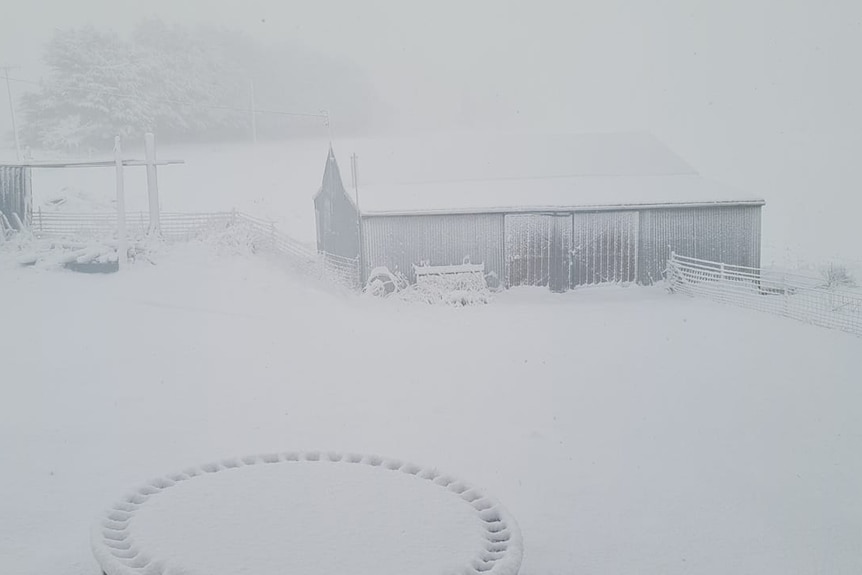
Collins Cap at Collinsvale blanketed in heavy snow [Lily Taylor].
Meteorologist Luke Johnston said the snowfall was brought about by an Antarctic front that caused “damaging and destructive north-westerly wind gusts” on Sunday.
“Vigorous cold fronts of this magnitude that bring damaging winds and snowfalls to low levels are relatively rare,” added Johnston. And while Tasmania does indeed experience dozens of cold fronts each year, they are usually “much less significant than the one that passed on the weekend,” said Johnston.
Rachel Power, who owns the Mt Field’s Waterfalls Cafe, north-west of Hobart, said the recent snow was “absolutely amazing”.

Also, check out yesterday’s
later than usual article, if you haven’t already:
Dr. Connolly: "The IPCC have hampered scientific progress into genuinely understanding the causes of recent and future climate change."

electroverse.net
The
COLD TIMES are returning, the mid-latitudes are
REFREEZING, in line with
the great conjunction,
historically low solar activity,
cloud-nucleating Cosmic Rays, and a
meridional jet stream flow (among other forcings).
Both NOAA and NASA appear to agree,
if you read between the lines, with NOAA saying we’re entering a
‘full-blown’ Grand Solar Minimum in the late-2020s, and NASA seeing this upcoming solar cycle
(25) as “
the weakest of the past 200 years”, with the agency correlating previous solar shutdowns to prolonged periods of global cooling
here.
Furthermore, we can’t ignore the slew of new scientific papers stating the immense impact
The Beaufort Gyre could have on the Gulf Stream, and therefore the climate overall.

 Prepare accordingly
Prepare accordingly—
learn the facts, relocate if need be, and grow your own.
































